
Rajshahi Division is one of the eight first-level administrative divisions of Bangladesh. It has an area of 18,174.4 square kilometres (7,017.2 sq mi) and a population at the 2022 Census of 20,353,119. Rajshahi Division consists of 8 districts, 70 Upazilas and 1,092 Unions.
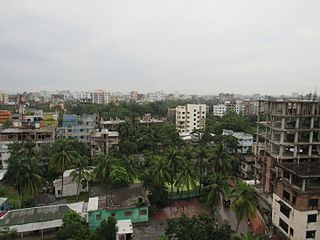
Comilla District, officially known as Cumilla District, is a district located in southeastern Bangladesh. It lies about 100 kilometres south east of Dhaka. Comilla is bordered by Brahmanbaria and Narayanganj districts to the north, Noakhali and Feni districts to the south, Tripura state of India to the east and Munshiganj and Chandpur districts to the west.
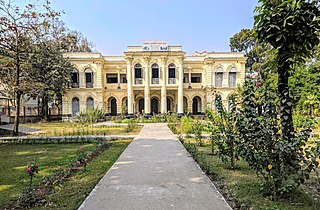
Pabna District is a district in central Bangladesh. It is an economically important district. Its administrative capital is the eponymous Pabna town.

Mahasthangarh is the earliest urban archaeological sites discovered thus far in Bangladesh. The village Mahasthan in Shibganj upazila of Bogra District contains the remains of an ancient city which was called Pundranagara or Paundravardhanapura in the territory of Pundravardhana. A limestone slab bearing six lines in Prakrit in Brahmi script recording a land grant, discovered in 1931, dates Mahasthangarh to at least the 3rd century BCE. It was an important city under the Maurya Empire. The fortified area was in use until the 8th century CE.

Bogra, officially known as Bogura, is a city located in Bogra District, Rajshahi Division, Bangladesh. The city is a major commercial hub in Northern Bangladesh. It is the second largest city in terms of both area and population in Rajshahi Division. The Bogra bridge connects the Rajshahi Division and Rangpur Division.
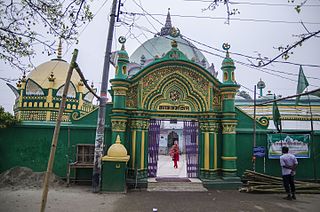
Sirajganj District is a district in the North Bengal region of Bangladesh, located in the Rajshahi Division. It is the 25th largest district by area and 9th largest district by population in Bangladesh. It is known as the gateway to North Bengal.

Adamdighi Upazila is an upazila of Bogra District in the Division of Rajshahi, Bangladesh. Adamdighi Thana was established in 1821 and was converted into an upazila in 1983. It is named after its administrative center, the town of Adamdighi. Local legend has it that its name came from a Muslim saint, Baba Adam, who visited and dug a dighi (tank) for water storage.

Bogra Sadar Upazila is an upazila of Bogra District in the Division of Rajshahi, Bangladesh. Bogra Thana was established in 1821 and was converted into an upazila in 1983. The upazila takes its name from the district and the Bengali word sadar (headquarters). It is the subdistrict where the district headquarters, Bogra town, is located.

Dhunat Upazila is an upazila of Bogra District in the Division of Rajshahi, Bangladesh.
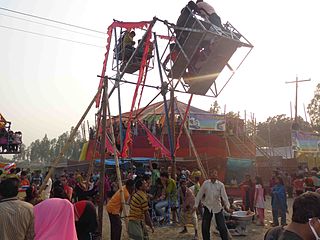
Gabtali is an upazila of the Bogra District, located in Bangladesh's Rajshahi Division. It is named after its administrative centre, the town of Gabtali and is best known as the home upazila of Ziaur Rahman, the late President of Bangladesh. Gabtali town is 7 km north of Bogra.
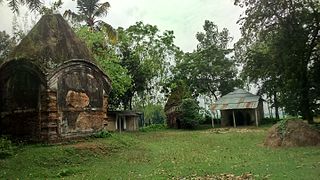
Kahaloo Upazila is an upazila of Bogra District in the Division of Rajshahi, Bangladesh. Kahaloo Thana was established in 1928 and was converted into an upazila in 1983. It is named after its administrative center, the town of Kahaloo.

Sariakandi Upazila is an upazila of Bogra District in the Division of Rajshahi, Bangladesh. Sariakandi Thana was established in 1886 and was converted into an upazila in 1983. It is named after its administrative center, the town of Sariakandi.
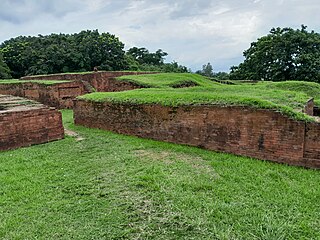
Shibganj Upazila is an upazila of Bogra District in the Division of Rajshahi, Bangladesh. The upazila was created in 1983. It is named after its administrative center, the town of Shibganj.

Sonatala Upazila is an upazila of Bogra District in the Division of Rajshahi, Bangladesh. Sonatala Thana was established in 1981 from Sariakandi Thana and was converted into an upazila in 1984. It is named after its administrative center, the town of Sonatala.
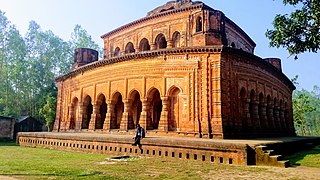
Ullapara is an upazila, or sub-district of Sirajganj District, located in Rajshahi Division, Bangladesh.
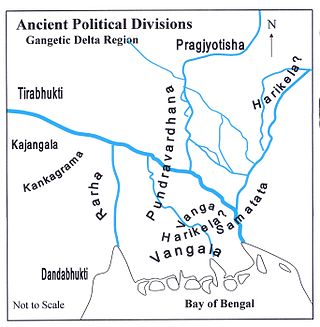
Pundravardhana or Pundra kingdom, was an ancient kingdom of Iron Age South Asia located in the Bengal region of the Indian subcontinent with a territory that included parts of present-day Rajshahi and parts of Rangpur Division of Bangladesh as well as the West Dinajpur district of West Bengal, India. The capital of the kingdom, then known as Pundranagara, was located at Mahasthangarh in Bogra District of northern Bangladesh.

Varendra, also known as Barind, was an ancient and historical territory of Northern Bengal, now mostly in Bangladesh and a little portion in the Indian state of West Bengal and Eastern Bihar.

Shajahanpur Upazila is an upazila of Bogra District in the Division of Rajshahi, Bangladesh. Created in 2003, it is the newest upazila in the District.

Ibrahim Shah Sultan Balkhi, also known by his sobriquet, Mahisawar, was a 16th-century Muslim saint. He is associated with the spread of Islam in Sandwip and Bogra.

The divisions of Bangladesh are further divided into districts or zilas. The headquarters of a district is called the district seat. There are 64 districts in Bangladesh. The districts are further subdivided into 495 subdistricts or upazilas.



























